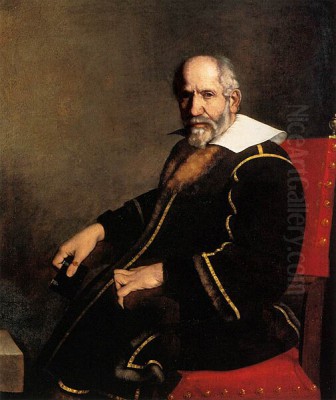
Carlo Ceresa stands as a significant figure in the landscape of 17th-century Italian art, particularly within the rich artistic milieu of Lombardy. Active during the vibrant Baroque period, Ceresa carved a distinct niche for himself, primarily celebrated for his insightful portraiture and compelling religious compositions. Though perhaps less internationally renowned than contemporaries working in Rome or Venice, his contribution to the Bergamasque school and the broader Lombard tradition of naturalism remains undeniable. His work offers a fascinating window into the society, piety, and artistic sensibilities of his time and place.
Born in San Giovanni Bianco, a small town near Bergamo, on January 20, 1609, Ceresa's life spanned a dynamic era in Italian history and art. He passed away in Bergamo on January 29, 1679, leaving behind a substantial body of work that continues to be studied and appreciated. As an Italian painter, his career unfolded primarily in and around Bergamo, a city with a strong artistic identity, somewhat independent from the dominant trends emanating from the major artistic capitals. His professional life was dedicated to capturing the likenesses of the local elite and fulfilling commissions for the region's churches, embedding his art deeply within the fabric of his community.
Early Influences and Artistic Formation
While details of Carlo Ceresa's earliest training remain somewhat scarce, it is widely accepted that his formative years were significantly shaped by the artistic environment of Lombardy. He likely received initial training in Bergamo before potentially spending time in Milan. A crucial influence on his development was the Milanese painter Daniele Crespi (c. 1598–1630). Crespi himself was a prominent figure in the Lombard school, known for his sober naturalism, dramatic intensity, and emotional depth, qualities often associated with the Counter-Reformation's call for clear and moving religious art.
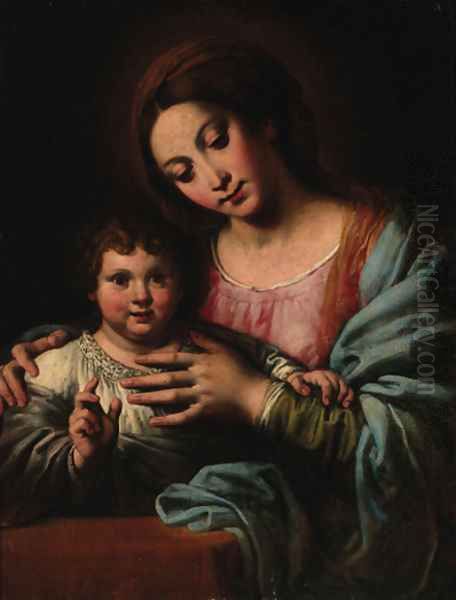
Crespi's style, which blended Lombard realism with influences from artists like Guido Reni and the Procaccini family (Giulio Cesare Procaccini and Camillo Procaccini), provided a powerful model for the young Ceresa. It is believed that Ceresa worked in Crespi's studio, absorbing his approach to composition, color, and the depiction of human emotion. This apprenticeship likely steered Ceresa away from the lingering complexities of late Mannerism towards a more direct, observational, and naturalistic mode of representation, a hallmark that would define much of his career.
Furthermore, Ceresa operated within a region that already possessed a strong tradition of realistic portraiture, most famously exemplified by the 16th-century Bergamasque master Giovanni Battista Moroni. Moroni's legacy of unidealized, psychologically penetrating portraits undoubtedly provided a crucial precedent for Ceresa. While Ceresa developed his own distinct style, the emphasis on capturing individual likeness with honesty and dignity, characteristic of Moroni, resonates in Ceresa's portrait work. This Lombard inclination towards realism, perhaps less theatrical than Roman Baroque, offered a fertile ground for Ceresa's talents.
The Development of a Naturalistic Style
Emerging from his training, Carlo Ceresa forged a personal style characterized by a commitment to naturalism, tempered with a certain elegance and sensitivity. His artistic journey saw a gradual shift from the stylistic echoes of late Mannerism, possibly visible in his earliest works, towards a more mature Baroque naturalism under the influence of Daniele Crespi. This transition involved embracing a more direct observation of the world, a clearer articulation of form, and a more emotionally resonant depiction of his subjects.
Ceresa's naturalism was not the stark, often brutal realism associated with Caravaggio, whose influence was profound but manifested differently in Lombardy than in Rome or Naples. Instead, Ceresa's approach was often gentler, characterized by careful modeling, a sensitivity to texture, and a nuanced use of light. He employed what has sometimes been described as a "spiritual light," using chiaroscuro not just for dramatic effect but also to highlight the inner state or significance of his figures, particularly in religious scenes. His palette often featured soft, harmonious colors, contributing to the overall sense of composure and dignity in his work.

Compared to the high drama and dynamic movement favored by masters like Gian Lorenzo Bernini in Rome, Ceresa's compositions often possess a sense of stillness and introspection. This is particularly evident in his portraits, where the focus is squarely on the sitter's presence and psychology, rather than on elaborate settings or overt displays of status, although details of costume and bearing are always meticulously rendered. His style represents a specific strand of the Baroque – one rooted in Lombard traditions of observation and less concerned with overwhelming grandeur than with clarity and sincerity.
Master of Portraiture
Carlo Ceresa's reputation rests significantly on his exceptional skill as a portraitist. He became the painter of choice for the aristocracy and upper classes of Bergamo and the surrounding region throughout the mid-17th century. His portraits are distinguished by their remarkable realism, psychological acuity, and dignified presentation. He possessed a keen ability to capture not just a physical likeness but also a sense of the sitter's personality and social standing, without resorting to excessive flattery or idealization.
His sitters often engage the viewer with a direct, steady gaze, creating an intimate connection across the centuries. Ceresa paid meticulous attention to the rendering of fabrics, lace, and jewelry, details that conveyed the wealth and status of his patrons, yet these elements rarely overshadow the human presence at the core of the portrait. Works like his portraits of the Vertova family exemplify his approach: sober yet elegant, detailed yet focused, revealing the individual within their social context.
In the tradition of Lombard portraiture established by Moroni, Ceresa presented his subjects with an air of naturalness and immediacy. However, his Baroque sensibility is evident in the slightly softer modeling, the more nuanced play of light and shadow, and perhaps a greater emphasis on conveying a sense of inner life or mood compared to the often starker objectivity of Moroni. While lacking the flamboyant brushwork of a Velázquez or the courtly elegance of an Anthony van Dyck, Ceresa's portraits possess a quiet intensity and honesty that give them enduring power. He documented the faces of his time and place with clarity and empathy.
Religious Works and Devotional Art
Beyond his celebrated portraits, Carlo Ceresa was also a prolific painter of religious subjects. He received numerous commissions for altarpieces and devotional paintings for churches throughout Bergamo and the surrounding valleys, contributing significantly to the region's sacred art. These works demonstrate his ability to translate the naturalistic style honed in portraiture to the demands of narrative and devotional imagery, aligning with the Counter-Reformation's emphasis on clear, emotionally engaging religious art that could instruct and inspire the faithful.
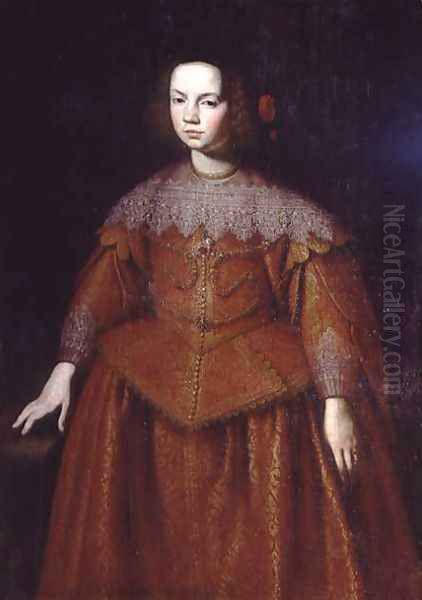
His religious compositions often feature solid, clearly defined figures depicted with a sense of gravity and piety. Representative works include altarpieces for the Church of San Gallo and the Basilica di Santa Maria Maggiore in Bergamo. His painting St. Vincent, depicting the martyr looking towards heaven surrounded by angels, showcases his ability to combine realistic detail (like contemporary dress) with a sense of divine encounter. Works created for the Church of Sant'Antonio Abate, such as a Madonna and Child, further illustrate his capacity for tender and accessible depictions of sacred figures.
Ceresa also undertook sculptural work, notably the wooden statues of St. Mark, St. Peter, and St. Paul for the church in Sentino. This versatility underscores his engagement with different forms of artistic production for ecclesiastical patrons. In his religious paintings, Ceresa often employed his characteristic use of light to create a spiritual atmosphere, illuminating key figures or moments. The emotional tenor is typically one of sincere piety and devotion, avoiding excessive melodrama while still conveying the gravity or tenderness of the scene. His work in this genre places him alongside other Lombard religious painters of the era, such as Cerano (Giovanni Battista Crespi) and Giulio Cesare Procaccini, contributing to the region's distinct interpretation of Baroque religious themes.
The Lombard Context: Tradition and Regionalism
Understanding Carlo Ceresa requires appreciating the specific artistic context of Lombardy, particularly Bergamo, in the 17th century. This region had a long-standing tradition of realism and careful observation, dating back to the Renaissance with artists like Vincenzo Foppa, and continuing through figures like Moretto da Brescia, Girolamo Savoldo, and, most relevantly for portraiture, Giovanni Battista Moroni. This "Lombard realism" provided a foundation upon which Baroque naturalism could build.
Bergamo, while politically linked to Venice for a long period, maintained a degree of cultural and artistic independence. It was less directly impacted by the grand theoretical debates and stylistic revolutions centered in Rome or Florence. This relative isolation may have fostered a more conservative artistic climate in some respects, but it also allowed for the development of distinct regional characteristics. Ceresa's art embodies this: it is clearly Baroque in its naturalism and emotional sensitivity, yet it retains a certain sobriety and directness rooted in local traditions.
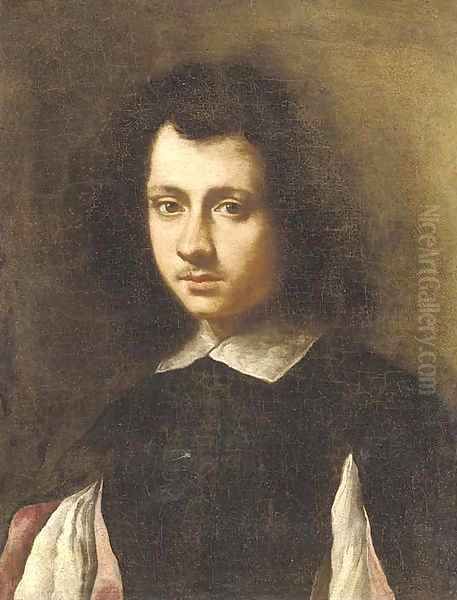
His focus on portraiture for the local gentry and religious works for regional churches cemented his position within this specific environment. He was not an artist seeking international fame through grand papal commissions or royal courts, like Bernini or Rubens. Instead, his career was deeply intertwined with the social and religious life of Bergamo and its territories. His style, influenced by Milanese trends (via Crespi) but firmly grounded in Bergamasque sensibilities, reflects this regional identity. He represents a vital aspect of the Italian Baroque often overlooked in surveys focusing solely on the major centers – the flourishing of distinctive artistic schools in provincial hubs.
Later Life, Workshop, and Legacy
Carlo Ceresa remained active as a painter throughout his life, establishing a successful workshop in Bergamo. Evidence, including his will, suggests that in his later years, his sons assisted him and eventually took over the management of the studio. This practice was common, ensuring the continuation of a workshop's style and the fulfillment of ongoing commissions. The anecdote that Ceresa and his wife had eleven children, five of whom died young, adds a poignant personal dimension, hinting at the personal tragedies that may have subtly informed the emotional depth found in some of his works.
He passed away in 1679, recognized as one of the leading painters in Bergamo. His legacy lies primarily in his contribution to Lombard Baroque painting. He successfully adapted the naturalistic impulses of the era to the specific tastes and needs of his regional clientele, excelling particularly in portraiture where his observational skills and psychological insight shone. His religious works also played a significant role in adorning the churches of the area, reflecting the devotional spirit of the time.
While perhaps overshadowed on the grand stage of Italian Baroque art by figures like Caravaggio, the Carracci brothers (Annibale and Agostino), or later masters, Ceresa holds a secure place in the history of Lombard art. His paintings are valued for their technical skill, their honest portrayal of individuals, and their sincere expression of religious feeling. He represents a crucial link in the chain of Lombard naturalism, carrying forward the legacy of Moroni and adapting the innovations of Crespi to create a body of work that is both historically significant and aesthetically compelling. His art continues to offer valuable insights into the society and culture of 17th-century Bergamo.
Ceresa in the Broader European Context
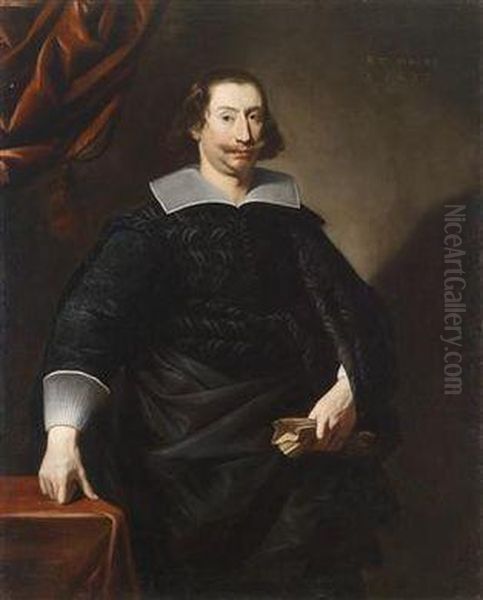
While Carlo Ceresa's sphere of activity was primarily regional, placing his work within the broader context of 17th-century European painting helps to appreciate his specific contributions. The Baroque era saw an explosion of artistic talent across the continent, with distinct national and regional schools flourishing. In Italy, the dramatic naturalism of Caravaggio and the dynamic classicism of the Carracci in Rome set powerful precedents. Ceresa's quieter, more observational naturalism offers a contrast, aligning more closely with the Lombard tradition.
Elsewhere in Europe, portraiture was reaching new heights. In Spain, Diego Velázquez was creating profound and complex portraits for the royal court. In Flanders, Peter Paul Rubens produced exuberant Baroque portraits, while his pupil Anthony van Dyck established a model of elegant court portraiture that became influential across Europe, especially in England. In the Dutch Republic, Rembrandt van Rijn explored human psychology with unprecedented depth through portraiture and history painting, while artists like Frans Hals captured fleeting moments with lively brushwork.
Compared to these giants, Ceresa's work might seem more modest in ambition and scope. He did not engage in the vast decorative schemes of Rubens or the intense spiritual drama of Rembrandt. However, his focus on capturing individual likeness with clarity and dignity holds its own value. His style represents a particular Italian response to the broader European trend towards naturalism, one filtered through local traditions and patronage. His commitment to realistic representation, combined with a sensitivity to character, ensures his portraits remain engaging and relevant, offering a distinct flavor within the rich tapestry of Baroque art.